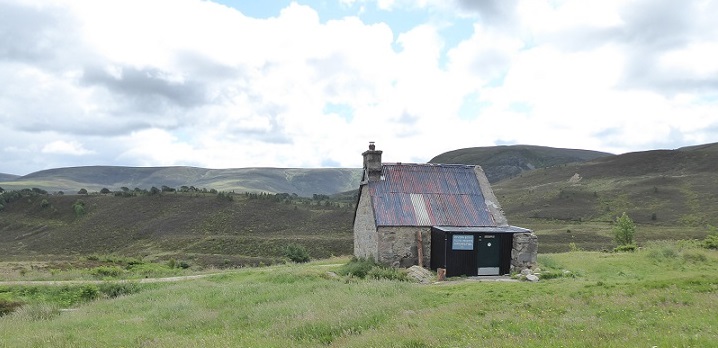
Despite a huge budget, hubris threatens to make the Shared Rural Network (SRN) a wasted opportunity for rural communities with inadequate mobile coverage. Without bothering to ask communities what was needed, the SRN set itself this target:
- To bring 4G coverage, from at least one operator, to 95%of UK land area.
To achieve this area target, the entire £320M SRN budget is allocated to 260 masts in the remote Highlands: uninhabited wilderness with no communities or roads. A wasteful, damaging disaster for Scotland, epitomised by the plan for a mast at Ryvoan in the Cairngorms.
This mast, 300m from Ryvoan Bothy, requires a second repeater mast in Glenmore to connect it to the Three network at Aviemore:
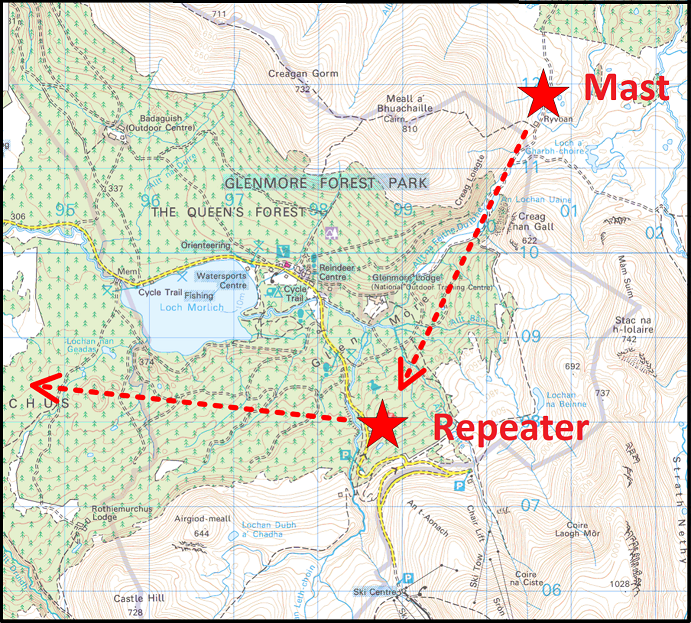
So far, a planning application (2024/0150/DET see here) has only been submitted for the repeater mast when the two should clearly be considered together.. It has been called in by the Cairngorms National Park Authority and is open for comments until 15th July.
As with other masts in the government-funded element of SRN, the area of ‘new’ coverage which would be provided by the Ryvoan mast is largely uninhabited, with few public roads. It doesn’t need roads (or phone masts). This precious resource is owned and nurtured by the RSPB. In fact, the application shows that even the 20 premises within range of the mast are ignored in favour of geographical spread:
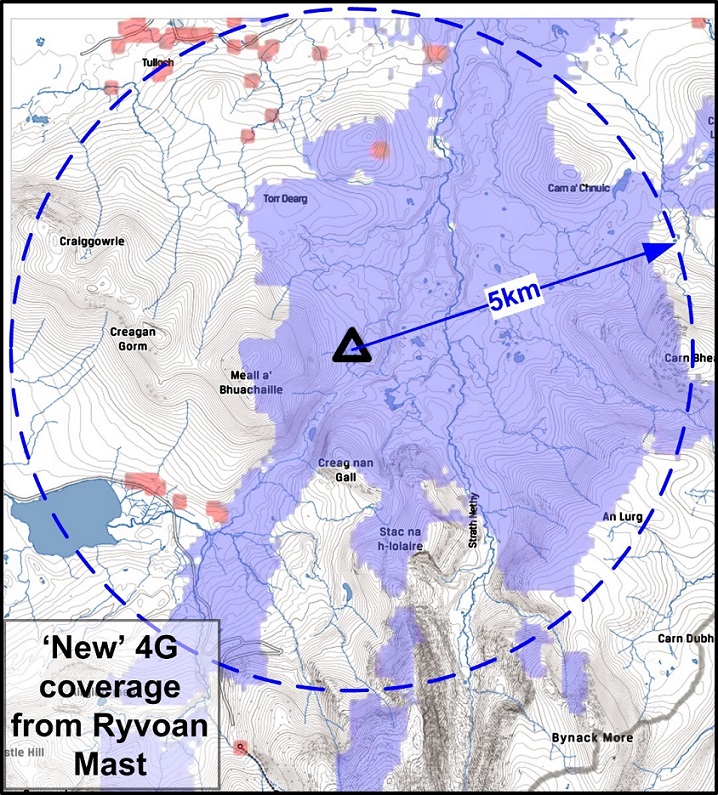
The SRN target is coverage from at least one operator, which could help customers in a fixed location but is of little use to those on the move outdoors. Most of the ‘new coverage’ area is in fact already covered by O2, EE and Vodafone from existing masts outside the sensitive area.
The Ofcom coverage map (see here) extract below does indeed show a small ‘4G Total Not Spot’: near Ryvoan and Lochan Uaine, the Green Loch. Ofcom also predict that Voice coverage, including 999 calls, is available everywhere on this map.
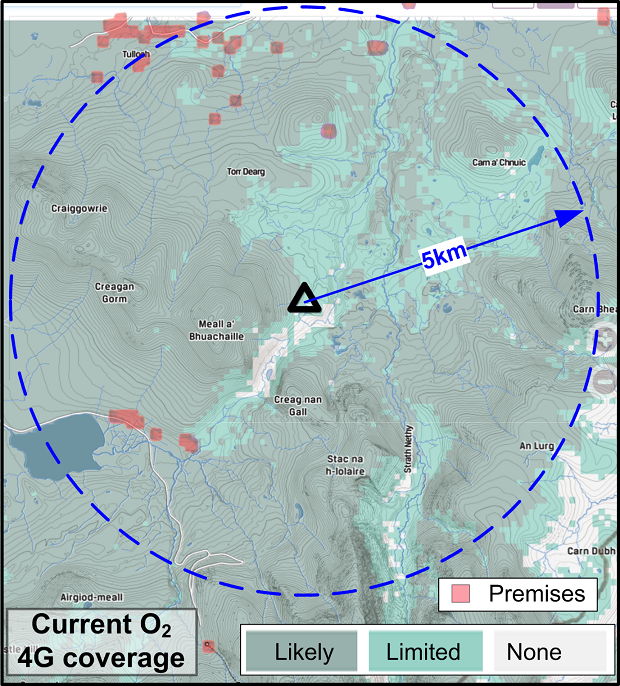
Nearby residents and tourists know of many ‘partial not spots’ where some phones work and some don’t. 4G reception is poor at Loch Morlich, and around the Osprey Centre to the North. This is where the money should be spent, these are the missed opportunities. Useful additional coverage would be possible from the site of the repeater mast. But because it is a government-funded mast targeting TotalNotSpots, it has no transmitting antennas! Tourists just get the eyesore, not the benefits.
The repeater mast will be an eyesore, but pales in comparison with the visual vandalism at the iconic Ryvoan Bothy, long famous as a sanctuary from a largely developed world. The mast is right beside the path from Nethybridge, as it bursts out of the pines to a stunning vista of the Cairngorms and inspired these lines from a frequent English visitor in the 1940s:
I shall leave tonight from Euston
By the seven-thirty train,
And from Perth in early morning
I shall see the hills again.
And again in dusk of evening
I shall find once more alone
Lone waters of the Green Loch
And the pass beyond Ryvoan
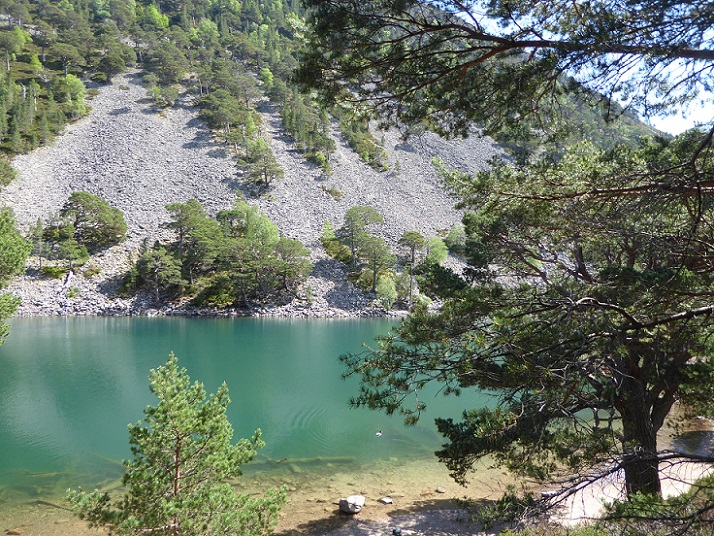
There was an excellent article (see here) by Nan Spowart in the Sunday National about the Ryvoan mast at the weekend which included this quote from a spokesperson for the UK Department for Science, Innovation and Technology:
“All proposed mast sites are assessed to consider a wide range of factors, including the benefits to surrounding communities, value for money and consideration to areas of natural beauty”.
It is important that the Cairngorms National Park Authority when assessing the applications for the Ryvoan mast and its “repeater” does just that and considers the combined impact/utility of both masts. You can comment on the repeater planning application here and parkswatch will try to alert readers if and when an application for the mast by Ryvoan bothy is submitted.

This is a disproportionate (cost/benefit) waste of public funds….money would be better spent filling pot holes and/or reducing electricity connectivity charges.
Good article with useful analysis, thank you. These applications just keep on coming while those with the power to stop the juggernaut and sort out the mess continue to duck their responsibilities. If I had a tenner for every objection I’ve written so far I’d be able to afford a holiday …
Just tried to make an objection, but it didn’t seem to submit and I note there are currently no other objections, which seems a bit odd. Has anyone else tried and does it seem to be working for you?
I have just submitted an objection – I forgot to tick the commenter type options and my comment was initially rejected but when I filled in this box it accepted the comment. Comments don’t get automatically posted to the planning portal, they are looked at by planning officers first and that can take a time
Objections can take a week or more to appear on the planning portal, so don’t worry if it looks like nobody else has commented. If you think yours may not have been submitted, send it by email to the planning authority instead.
I’m surprised the Nats haven’t jumped on this as another example of Westminster not listening to Scotland; I wonder why not? Especially in iconic landscapes such as Glenmore, Glencoe and Torridon.
The problem is the SNP now favours development, any development, over landscape and wild land. It does not matter what you dig up because, as Keynes argued, it creates job and is good for capitalism. Other political parties share that view. The last nationalist to do anything for the landscape was Alex Salmond who gave the go ahead to giving Wild Land Areas some protection under the planning system. NPF4 has weakened that.
Unacceptable will ruin the beauty and tranquility of this precious area